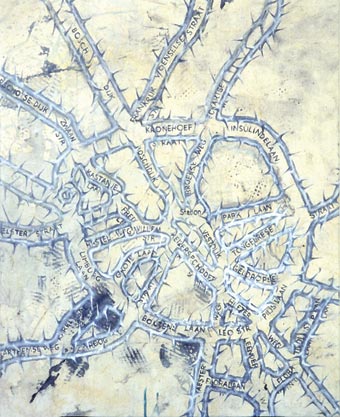Next story: Rioting! In The Suburbs
Maps & Boundaries
by Jack Foran

Painter Guillermo Kuitca travels paths of his own creation between public facts and the intimate imagination
Maps and beds are the polar motifs in a huge retrospective of mainly paintings by Argentine artist Guillermo Kuitca currently at the Albright-Knox. The show is entitled Everything, and the title is only a bit of a hyperbole.
Maps represent public space. Beds are private space, and the locus of an enormous portion of the most significant human experience, including lovemaking, birth, and death. Not to mention roughly a third of our lives in sleep.
The maps include real and imaginary city and country maps and related orderly arrangements such as theater seating charts (theater is one of Kuitca’s long-standing enthusiasms) and architectural plans and manipulated architectural images that probably began life as photos.
But the almost obsessive interest in order and arrangement is tempered by an equal interest in the breakdown of these principles.


A series of “flotation” works consists of computer-downloaded theater seating charts, lushly colored and printed on special paper, whereupon the paper was floated in water, causing the imagery to float slightly off the paper surface before being recaptured, distorted and disintegral, but still recognizable in terms of the original image.
A related series resonates with the current global political action thematic of suicide and other bombings that introduce what were formerly public-realm military strategies into ostensibly private and peaceful arenas. Depictions of baroque church-like structures are shown fragmented as if at the moment of an explosion. The visual beauty (but only for an instant) within the moral horror.
The explosion idea then is applied to the maps. One gargantuan exploded-maps piece is reminiscent of the work of Jackson Pollock, for its huge size and its abstract quality based on its intricate and fundamentally homogenous patterning. But unlike with Pollock, where the patterning is the result of and explicit record of the painter’s individual artistic energy, here the energy seems more from within the work.
In the first place, the original map patterning is based on the communal and historical energy and purposes of the generations of travelers who created this template. Then the explosion energy that alters the template seems to come from within. The resultant template distortions then suggest topographical contours. Ultimately, the piece is about more universal than individual ordering forces of historical time and even geological time.
By way of intertwining the public/private space motifs, maps are painted on beds and on upholstered canvases, with upholstery buttons marking significant locations, such as cities, or travel route crossings. Other times, beds serve as alternative subject matter in what could be architectural plans for dormitories of a vaguely fascistical character.
A series of paintings and scrim curtains associated with stage designs for a production of Wagner’s opera The Flying Dutchman depict airport baggage claim carousels, to evoke the idea of an endless journey.
All in all, this is beautiful and even heroic work. In a public conversation with show curator Douglas Dreishpoon in conjunction with the opening, Kuitca talked about his ominous sense along the way that the art of painting was dead.
Painting has suffered a bad rap over the past few decades, elbowed off the stage, or at least center stage, by the somewhat brash, relatively newcomer arts of photography and film, and by positively newcomers video and performance art.
Kuitca said he had the feeling “paintings were impossible to conceive or make,” but struggled to prove himself wrong on this score. He said his continuing connections with other arts—particularly theater, but also literature and music—were inspirational in his project to extend the boundaries of painting, and so make it possible again.
On the matter of inspiration, he said the writer and fellow Argentine Jorge Luis Borges was “superinfluential” for having demonstrated “how pretty much everything is possible in a story.” Allowing Kuitca to apply the same principle to painting was the implication.
And why a retrospective of this painter, from remote Argentina, in Buffalo, at the Albright-Knox? Besides the commendable and sufficient reasons of providing a closer look at an extremely interesting artist, and paying some attention to the Latin world to the south we have historically paid so little mind to, there is a special Kuitca/Albright-Knox connection.
In the late 1960s, Dreishpoon explained, Seymour Knox took a large number of works from the Albright-Knox and put on an exhibit in Buenos Aires. He said Knox’s interest in Argentina was partly due to his interest in polo. Polo is big in Argentina, and Knox was a polo player.
Kuitca was eight years old at the time, and his parents took him to see the exhibit. It was his first look at works by a large number of important modern artists. And he apparently never looked back.
blog comments powered by Disqus|
Issue Navigation> Issue Index > v9n8 (week of Thursday, February 25) > Maps & Boundaries This Week's Issue • Artvoice Daily • Artvoice TV • Events Calendar • Classifieds |









 Current Issue
Current Issue